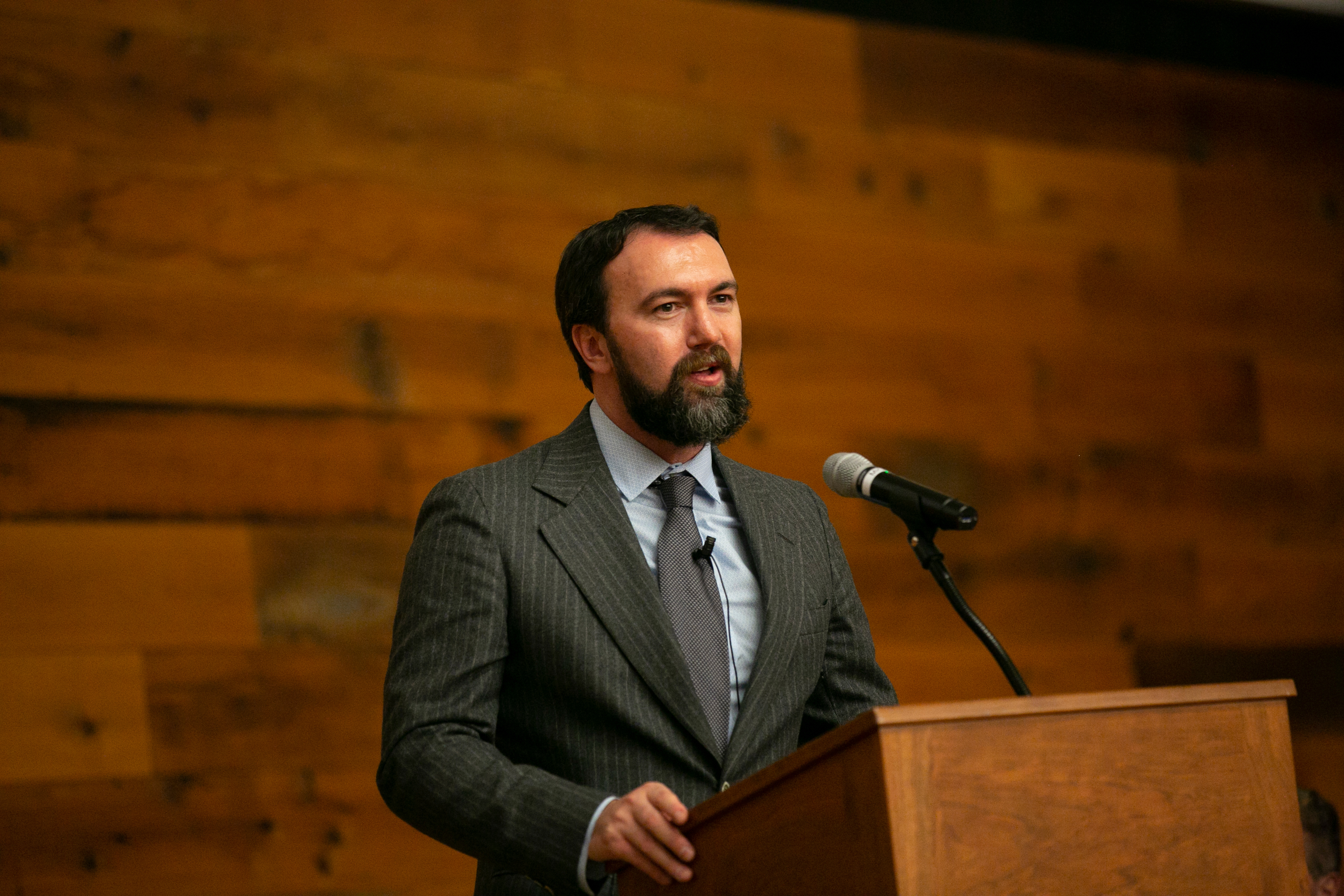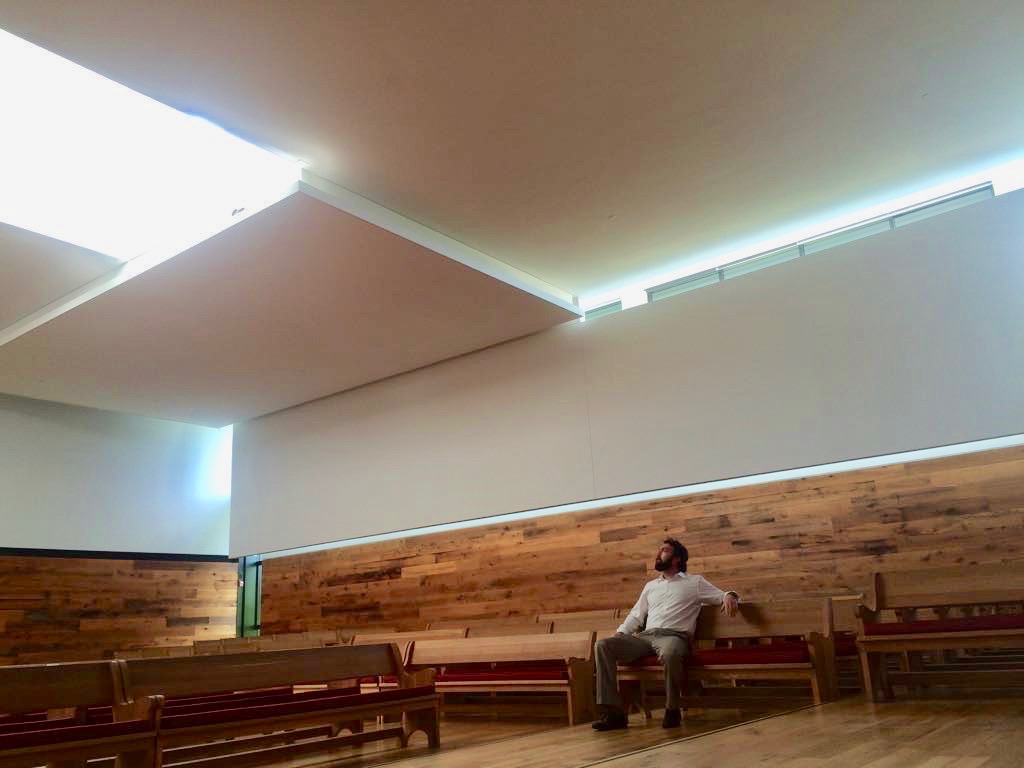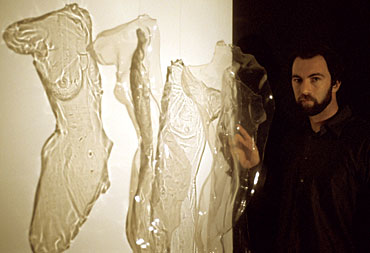home curator scholar sculptor biography resume contact
Biography AARON
QUINN BROPHY

Brophy speaking at Sidwell Friends School, 2018
Brophy was born in Norfolk, Virginia in 1975, with a bi-lateral cleft-lip and palate. Therein lie the roots of his vanity, and also his gratitude, for the surgeons and specialists who enabled Brophy to live an ordinary life. Within months, his parents moved to be closer to Children's Hospital of Philadelphia, where he underwent a series of corrective surgeries under the care of Dr. Linton Whitaker, Dr. Donato Larossa, and Dr. Rosario Mayro.
Raised in a Quaker community in Bucks County, Pennsylvania, Brophy earned his International Baccalaureate Diploma from George
School. Under the tutelage of his art teachers, Judy Bartella and his aunt, Nancy Williams, he honed his wheel throwing
skills in the ceramics studio where he also made his
first efforts at sculpting. His first experiments with low-fire sawdust techniques were inspired by his research on the blackware pottery of Pueblo artist, Maria Martinez. Brophy's IB thesis paper focused on Native American pottery styles. At an early age Brophy was influenced by legendary local artists, George Nakashima and Toshiko Takaezu. Although Brophy was born into a family of modest means, the creative experience of his childhood was steeped in abundance.
At age sixteen, with a scholarship from Solebury Friends Meeting, Brophy traveled to Europe as an exchange student. During his
month-long stay in Saint Petersburg, Russia, he made several visits to the
Hermitage Museum. These few days spent wandering the halls of the old
palace, examining its world class art collection, remain etched in his
memory. Three years later, Brophy made his second trip to
Europe. He spent a month painting the Umbrian landscape in Perugia, Italy. His
weekends were occupied studying sculptures and paintings in Rome,
Florence, and Venice.
Brophy's first encounter with the Belvedere Torso in Rome's Vatican Museum was awe inspiring. Ever since, he has been captivated by the aesthetics of time-scarred ancient figurative sculpture. Brophy spent the second half of the summer traveling through Europe by train. Filling numerous sketchbooks along the way, he visited many major art museums across the continent. The timing of Brophy's European tour happened to coincide with the wrapping of the Reichstag, by Christo and Jean-Claude. His pitstop in Berlin expanded Brophy's sense of scale, and the possibilities of public art projects. In 1997 he graduated with degrees in Art and Economics from Alfred University. At Alfred he focused mainly on life-sized figurative sculpture, combining ceramic, bronze, and wood elements via epoxy. He studied with a pantheon of legendary professors: Wayne Higby, Val Cushing, Anne Currier, Andrea Gill, and John Gill. There were other professors that impacted Brophy profoundly: painter Mario Prisco, sculptor Glenn Zweygardt, and art historian Gerar Edizel. Brophy was lucky to have crossed paths with Doug Jeck and Stephen DeStaebler during his time at Alfred. He is deeply indebted to both teachers, who significantly impacted the aesthetics of his most formative years. Brophy's education in upstate New York, also overlapped with graduate students such as Kristen Morgin and Sunkoo Yuh, who were already masters in their own right. Kristen Morgin's MFA thesis exhibition featured her series of cellos and violins made out of raw unfired clay. Brophy states that in Morgon's exhibition he witnessed the sublime numina of sculptural objects resting between wholeness and disintegration. |
|
It was glass artist, Stephen Dee Edwards who first encouraged Brophy to observe and study light in his art practice, and it was professor emeritus, Robert C. Turner who encouraged Brophy to wake up early on Sundays to attend meeting for worship, in Alfred. It is fitting that over twenty years later, Light and Quakerism define the creative environment that Brophy has cultivated for his own students, at Sidwell Friends School.
Brophy spent the summer after his college graduation as an artist-in-residence
on Ossabaw Island just off the coast of Savannah, Georgia.
He then toured the Western United
States, Canada, and Mexico. On his way back East, Brophy accidentally
found gainful employment as the Interim Curator of the Nicolaysen Art
Museum, in Casper, Wyoming. His first curatorial project was an art exhibition titled The Hundred Languages of Children, featuring the educational approach of the renown northern Italian town of Reggio Emilia. He was unaware at the time, but Brophy's lifelong career as a curator, as a teacher, and as an artist, had already begun.
|
|
Brophy also inadvertantly expanded the museum's contemporary art collection when a patron walked in one day, and offered to donate an early non-objective painting by Christo Javacheff. The young curator was still star-struck from the wrapped Reichtsag, just a few years earlier, and was entirely unprepared for the press conference to unveil the Christo. While wearing white gloves to protect the new accession, Brophy and the donor unwittingly held the painting upside-down, while posing for the newspaper photographer to memorialize their embarrassment. While still living in Wyoming, Brophy was awarded an artist grant
from the Elizabeth Greenshields Foundation. This funding allowed him the time and space to mount several exhibitions before his next European excursion. For the 1998-99 academic year, Brophy was awarded a Fulbright scholarship to pursue post-graduate studies on the Mediterranean island of Cyprus. After a few weeks on the beaches of Paphos, Brophy found an apartment and a moped, and settled in the
old city of Nicosia, where he lived during his fellowship at the Cyprus American Archaeological Research Institute. Brophy returned to the United States in 1999 to take a position as Artist-in-Residence at the Henry Luce III Center for the Arts at Wesley Theological Seminary. During this period he experimented for the first time with light directly, sculpting torsos by the heat of a propane torch. The shadows and the light of his translucent torsos resulted from a corporeal and conceptual prism, through which he would begin to reconsider established beliefs of materiality in his art practice, and in the artwork of others. |
In autumn 2000, Brophy joined the art faculty at Landon School in Bethesda, Maryland, where he taught for sixteen years. While at Landon School he held positions as the Art Gallery Curator and the Director of the Landon Summer Art Program. In 2002 Brophy was awarded the William C. Barbee Sculpture Prize from
George Washington University. And in spring 2003, Brophy participated in a teacher exchange program in China, lecturing at schools in Beijing, Chengdu, and Shanghai. Visiting the arhcaeological site of the Terra Cotta Warriors in Xi’an, and witnessing the Giant Buddhas of Leshan were truly inspirational.
From 2003 to 2009, Brophy was an adjunct professor of ceramic art, and art history at Montgomery College in Rockville, Maryland. During this time Brophy earned several awards. He was presented with an Individual Artist Grant from the Maryland State Arts Council, and Landon School recognized him with the Senator John C. Danforth Prize for Excellence in Teaching. |
|
In 2016, Brophy joined Sidwell Friends School in Washington, DC. At Sidwell, he has since established an art curriculum based on the literal and metaphorical study of light, within the context of a Friends education. Internationally recognized contemporary artists, James Turrell and Olafur Eliasson, are at the core of Brophy’s curriculum. In addition to teaching art, Brophy is also the Director of Art Exhibitions. Brophy maintains the school’s growing permanent art collection featuring several acclaimed artists, including Sam Gilliam, Gene Davis, Lou Stovall, and Nam June Paik. He is responsible for organizing professional and student art shows, and coordinating the annual visiting artist program.

Brophy in the Meeting Room at Sidwell Friends School, 2017

